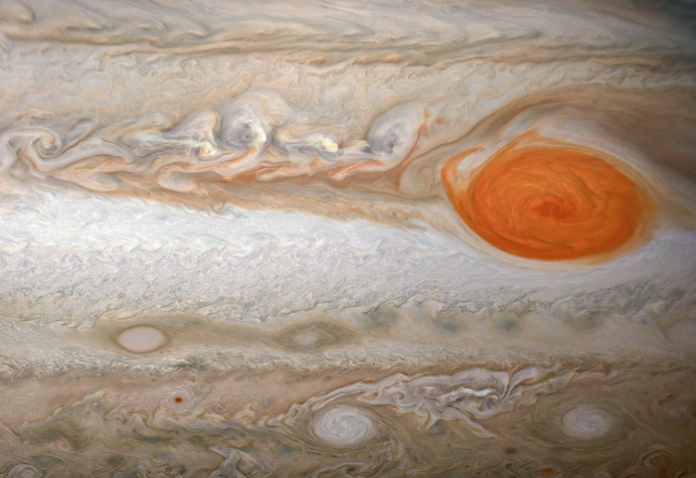A University of Leicester study looks at the mystery of “deeper, hidden layers” beneath Jupiter, using new data from NASA’s Juno spacecraft
The NASA Juno spacecraft has produced data after looking at Jupiter, which has been analysed by scientists at the University of Leicester.
The microwave radiometer, carried by Juno, looks at the banded pattern that extends deep below the clouds on the planet. The appearance of Jupiter’s belts and zones inverts near the base of the water clouds.
According to their analysis, the planet’s belts shine brightly in microwave light – especially at altitudes shallower than five bars of pressure, which is roughly five times the average atmospheric pressure on Earth.
However, things really change at higher pressures.
At altitudes deeper than 10 bars, scientists see an unexpected reversal in the meteorology and circulation. But why does this happen?
“Colourful bands are just the tip of the iceberg”, says Professor
Dr Leigh Fletcher, Associate Professor in Planetary Science at the University of Leicester and Participating Scientist for the Juno mission, is lead author of the study, published in the Journal of Geophysical Research-Planets. He said: “One of Juno’s primary goals was to peer beneath the cloudy veil of Jupiter’s atmosphere, and to probe the deeper, hidden layers.
“Our study has shown that those colourful bands are just the ‘tip of the iceberg’, and that the mid-latitude bands not only extend deep, but seem to change their nature the further down you go.
“We’ve been calling the transition zone the jovicline, and its discovery has only been made possible by Juno’s microwave instrument.”
So, what did the team find out about the changing light?
There are two possible mechanisms that could be responsible for the change in brightness, each implying different physical conclusions.
The team believe that there are two possible mechanisms behind the different light layers on Jupiter.
1. Distribution of ammonia gas
Ammonia is opaque to microwaves, meaning a region with relatively less ammonia will shine brighter in Juno’s observations. This mechanism could imply a stacked system of opposing circulation cells, similar to patterns in Earth’s tropics and mid-latitudes.
These circulation patterns would provide sinking in belts at shallow depths and upwelling in belts at deeper levels – or vigorous storms and precipitation, moving ammonia gas from place to place.
2. Corresponding temperature gradient
Another answer for the changing layers on Jupiter is that the gradient in emission corresponds to a gradient in temperature, with higher temperatures resulting in greater microwave emission.
Temperatures and winds are connected, so if this scenario is correct, then Jupiter’s winds may increase with depth below the clouds until we reach the jovicline, before tapering off into the deeper atmosphere – something that was also suggested by NASA’s Galileo probe in 1995, which measured windspeeds as it descended under a parachute into the clouds of Jupiter.
The likely scenario is that both mechanisms are at work simultaneously, each contributing to part of the observed brightness variation.
Dr Scott Bolton, of NASA’s Jet Propulsion Laboratory (JPL), is Principal Investigator (PI) for the Juno mission. He said: “These amazing results provide our first glimpse of how Jupiter’s famous zones and belts evolve with depth, revealing the power of investigating the giant planet’s atmosphere in three dimensions.”











